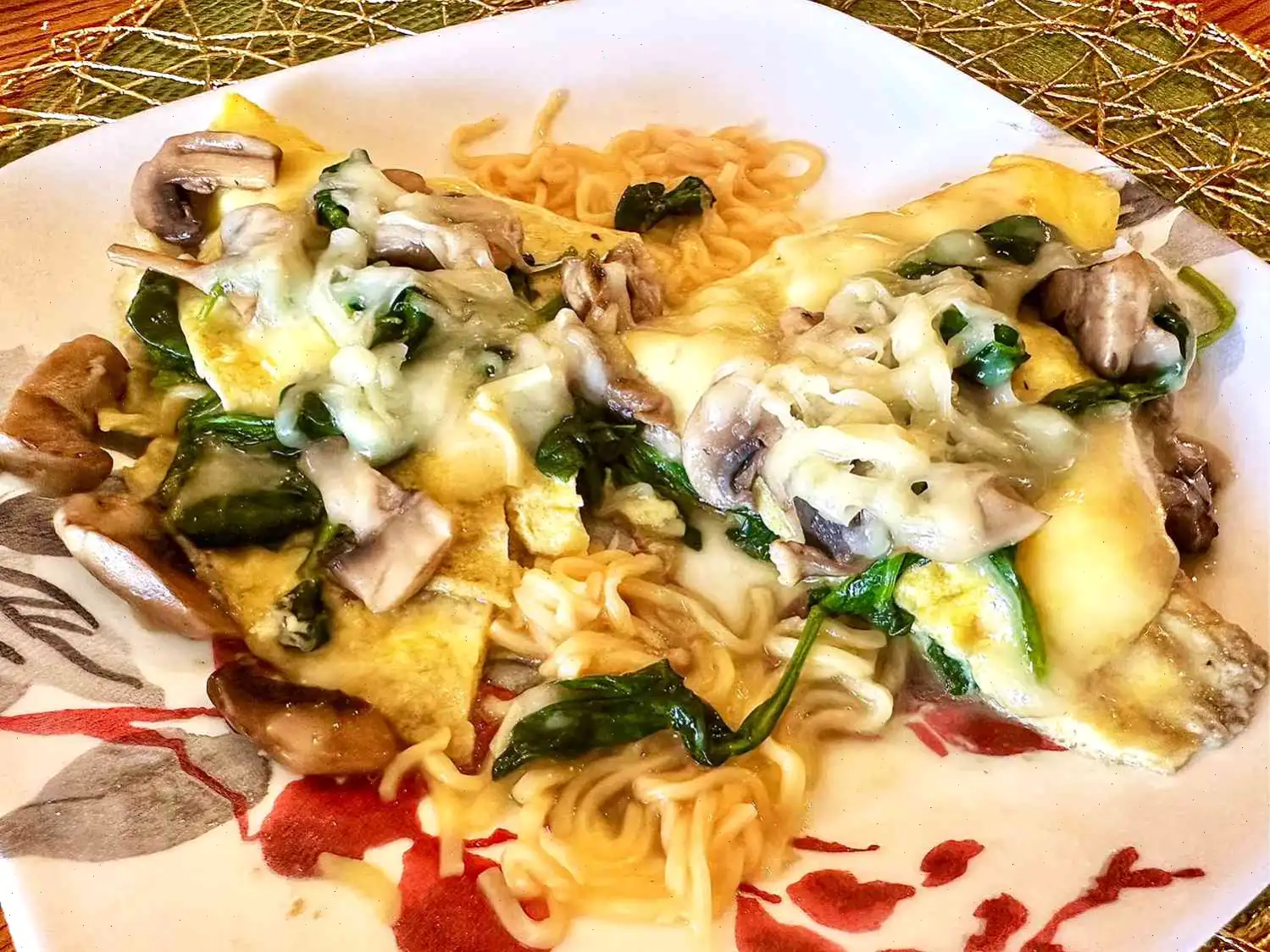
Ramen Omelet with Spinach, Mushrooms, and Cheese Recipe
This recipe is a delicious fusion of ramen, fresh spinach, mushrooms, and a cheesy, buttery omelet. Perfect for a quick and satisfying meal.
Ingredients
- 1 (3 ounce) package ramen (discard seasoning packet)
- 2 tablespoons butter, divided
- 2 cups fresh spinach
- 1 cup sliced mushrooms
- 2 large eggs
- 1 splash of milk
- 1/2 cup shredded Jack cheese
- Salt and freshly ground black pepper, to taste
Directions
Step 1: Bring 2 cups of water to a boil in a saucepan. Add the ramen and cook for about 3 minutes, or until tender. Drain and set aside.
Step 2: In a skillet, melt 1 tablespoon of butter over medium heat. Add the mushrooms and cook, stirring occasionally, for about 5 minutes, or until tender.
Step 3: Add the spinach to the skillet with the mushrooms. Continue to cook, stirring constantly, for about 2 minutes, or until the spinach is wilted. Remove from the skillet and set aside.
Step 4: In a bowl, whisk together the eggs and a splash of milk.
Step 5: In the same skillet, melt the remaining 1 tablespoon of butter. Pour in the egg mixture, then top with half of the cooked ramen, half of the mushroom-spinach mixture, and 1/4 cup of shredded Jack cheese. Season with salt and pepper to taste.
Step 6: Once the eggs are set, fold the omelet in half, then top with the remaining mushroom-spinach mixture and the remaining cheese. Cook for another minute, allowing the cheese to melt.
Nutrition Facts (per serving)
- Calories: 779 kcal
- Total Fat: 59g (75% Daily Value)
- Saturated Fat: 31g (156% Daily Value)
- Cholesterol: 523mg (174% Daily Value)
- Sodium: 1414mg (61% Daily Value)
- Total Carbohydrates: 28g (10% Daily Value)
- Dietary Fiber: 6g (20% Daily Value)
- Protein: 38g (77% Daily Value)
- Vitamin C: 24mg (26% Daily Value)
- Calcium: 602mg (46% Daily Value)
- Iron: 7mg (41% Daily Value)
- Potassium: 1211mg (26% Daily Value)
* Percent Daily Values are based on a 2,000-calorie diet. Your daily values may vary based on your individual needs.
History of Origin
The idea of combining ramen with an omelet is a relatively modern twist born from the global popularity of instant noodles. This fusion draws inspiration from Japanese comfort food traditions, where eggs and noodles often appear together in quick home-style meals. As ramen spread worldwide in the late 20th century, home cooks began experimenting, merging familiar Western breakfast staples with Asian noodles to create inventive dishes like the ramen omelet.
Regional Variations
In the United States, the dish typically features ingredients such as spinach, mushrooms, and cheese, reflecting local breakfast preferences. In Southeast Asia, variations often include chili oil, scallions, and seafood for a spicier flavor profile. Some versions in European households use regional cheeses or add cured meats, demonstrating the versatility of the base concept and its adaptability to local tastes.
How It Differs from Similar Dishes
Unlike traditional Japanese ramen, which features broth, proteins, and toppings, the ramen omelet is entirely broth-free and focuses on texture. Compared to classic Western omelets, this dish stands out because the noodles provide structure and a satisfying chewiness. While frittatas incorporate ingredients throughout the egg mixture, a ramen omelet layers components, resulting in a more defined contrast between the soft eggs, tender vegetables, and springy noodles.
Where It Is Commonly Served
The ramen omelet is most often enjoyed at home as a quick breakfast or lunch, especially by students and busy home cooks. Some casual cafs and fusion eateries include it on their brunch menus, presenting it as a playful reinterpretation of traditional omelets. It has also gained popularity on college campuses, where instant ramen is a staple and creative preparations are widely embraced.
Interesting Facts
One fun detail about this dish is that its rise in popularity is closely tied to viral cooking trends on social media, where quick fusion recipes spread rapidly. Because instant ramen cooks so quickly, it became a go-to ingredient for experimental omelets. Another interesting point is that chefs sometimes use flavored ramen varieties to subtly change the final taste, even when the seasoning packets are discarded, since the noodles themselves may carry mild flavor notes depending on the brand.








